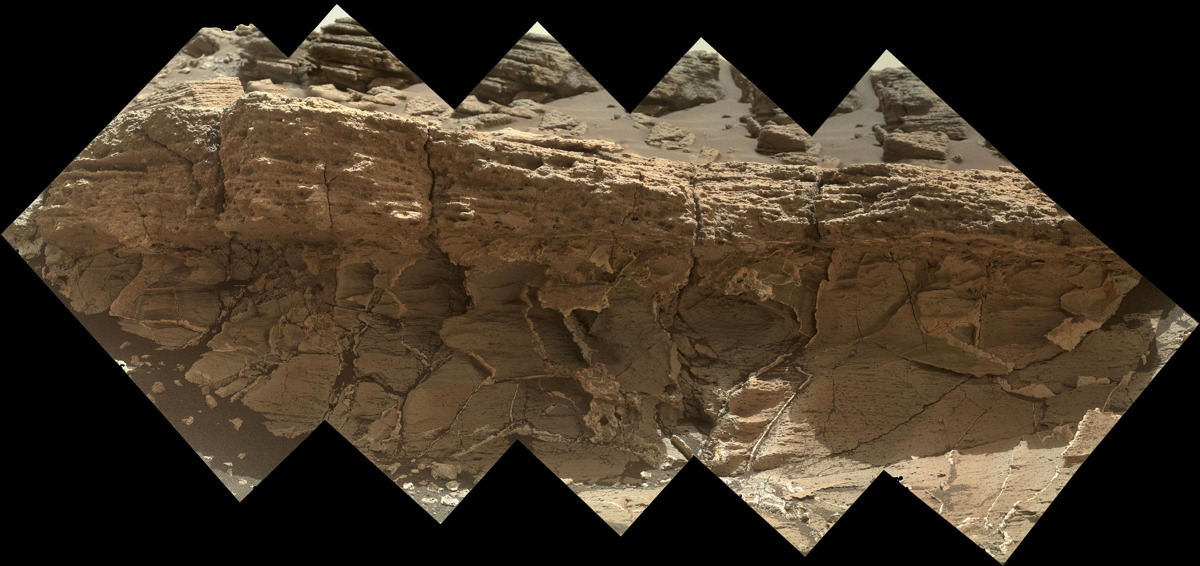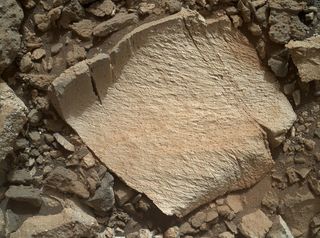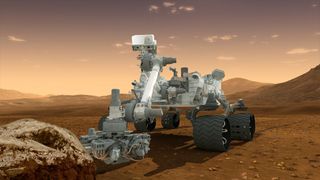
NASA's Mars rover Curiosity went out of its way to investigate a rock the likes of which it has never seen before on the Red Planet.
Measurements by Curiosity's rock-zapping ChemCam laser and another instrument revealed that the target, a chunk of bedrock dubbed Elk, contains high levels of silica and hydrogen, NASA officials said.
The abundance of silica — a silicon-oxygen compound commonly found here on Earth in the form of quartz — suggests that the bedrock may provide conditions conducive to the preservation of ancient carbon-containing organic molecules, if any exist in the area, the officials added. So Curiosity's handlers sent the rover back 151 feet (46 meters) to check Elk out. [Latest Amazing Mars Photos by NASA's Curiosity Rover]
"One never knows what to expect on Mars, but the Elk target was interesting enough to go back and investigate," ChemCam principal investigator Roger Wiens, of Los Alamos National Laboratory in New Mexico, said in a statement.
Elk lies near a spot on the lower reaches of the 3.4-mile-high (5.5 kilometers) Mount Sharp, called Marias Pass, whose rocks Curiosity had been studying. Marias Pass is a "geological contact zone" where dark sandstone meets lighter mudstone.
"We found an outcrop named Missoula where the two rock types came together, but it was quite small and close to the ground," Curiosity project scientist Ashwin Vasavada, of NASA's Jet Propulsion Laboratory in Pasadena, California, said in the same statement. "We used the robotic arm to capture a dog's-eye view with the MAHLI [Mars Hand Lens Imager] camera, getting our nose right in there."

ChemCam had fired at the Elk bedrock from the top of a small hill close to Marias Pass, which Curiosity had summitted before taking a look at the contact zone. After looking at the Missoula outcrop, the 1-ton rover began moving on, but an analysis of ChemCam's data persuaded the team to turn Curiosity around for a closer look at Elk, mission team members said.
Get the Space.com Newsletter
Breaking space news, the latest updates on rocket launches, skywatching events and more!
"ChemCam acts like eyes and ears of the rover for nearby objects," Wiens said.
As Curiosity gathers data, mission engineers continue to investigate a short circuit that cropped up in the rover's sample-collecting drill in February. No short circuits occurred during a July 18 engineering test, so the Curiosity team plans to conduct some drilling trials on rocks in the near future, NASA officials said.

Curiosity has been exploring Mars' 96-mile-wide (154 km) Gale Crater for nearly three years now. The six-wheeled robot touched down on the night of Aug. 5, 2012, on a mission to determine if Gale could ever have supported microbial life.
Curiosity scientists answered this question early in the mission, finding that Gale Crater once harbored an extensive lake-and-stream system that could have supported microbial life, if such organisms had ever evolved on the Red Planet.
Follow Mike Wall on Twitter @michaeldwall and Google+. Follow us @Spacedotcom, Facebook or Google+. Originally published on Space.com.
Join our Space Forums to keep talking space on the latest missions, night sky and more! And if you have a news tip, correction or comment, let us know at: community@space.com.

Michael Wall is a Senior Space Writer with Space.com and joined the team in 2010. He primarily covers exoplanets, spaceflight and military space, but has been known to dabble in the space art beat. His book about the search for alien life, "Out There," was published on Nov. 13, 2018. Before becoming a science writer, Michael worked as a herpetologist and wildlife biologist. He has a Ph.D. in evolutionary biology from the University of Sydney, Australia, a bachelor's degree from the University of Arizona, and a graduate certificate in science writing from the University of California, Santa Cruz. To find out what his latest project is, you can follow Michael on Twitter.